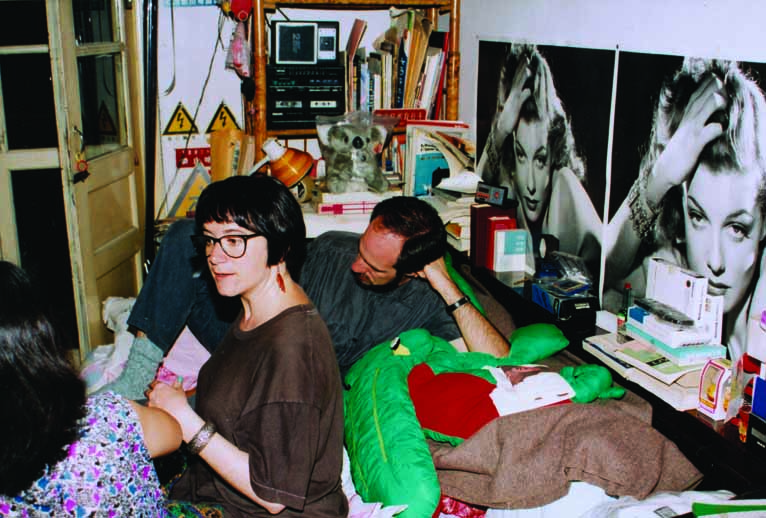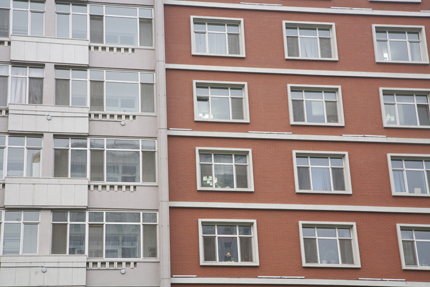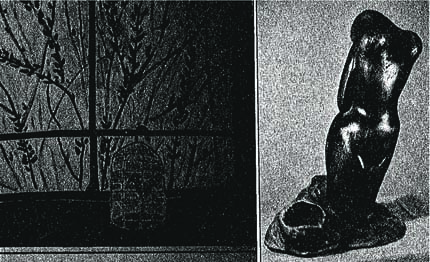THE FOREIGN SALONS OF BEIJING
| July 4, 2012 | Post In LEAP 15

The nightlife of Beijing is remarkably lackluster. Long-term foreign residents, bored stiff, often find themselves in search of a little entertainment. These laowai come in all stripes, and the good are mixed in with the bad. Of the various diversions they devise for themselves, one form is particularly noteworthy: “foreign salons” (yang shalong).
On the weekends, and Saturday night in particular, it is common for laowai residents of Qijiayuan, Sanlitun, and the diplomatic compound at Jianguomenwai to host groups of foreign and Chinese acquaintances for an evening of animated conversation. Of course, there is nothing more ordinary than throwing a party on the weekend and generating a bit of noise. But the foreign salons of which I write are a special type of event that have evolved into a particular cultural phenomenon.
THE FIRST GENERATION AND THE LEGACY OF THE CULTURAL REVOLUTION
Foreign salons share something in common with all other cultural salons, past and present: they consist of smug, literary-minded charlatans. These characters cluster together to match wits and words. They all seem confident that if there are any present-day heroes, it is them. As their numbers grow, alliances and feuds inevitably take shape and dissolve.
These salons do not have a long history. Strictly speaking, they have been around for less than a decade. Following the end of the Cultural Revolution, the rigid restrictions on contact between foreigners and Chinese were gradually replaced by a new set of highly flexible measures of control. Foreigners and locals are allowed limited informal contact. The early salons formed spontaneously. Around the time of the Beijing Spring of 1978-79, long-term foreign residents of Beijing— including journalists, diplomats, and students— were eager to get to know local people, and they finally had opportunities to meet Chinese counterparts who had some ability to speak a foreign tongue. The locals consisted of social activists, artists, writers (mostly poets), and various “idle people” hoping to hone their language skills. Together, they formed the first generation of foreign salon mavens in Beijing.
A few years passed in this way, but by the time of the 1983-84 Anti-Spiritual Pollution Campaign, many Chinese participants in the early salons had moved or been moved on. Of the artists— for the most part alums of the Stars Group— some had married foreigners and relocated overseas, while others decamped from Beijing of their own accord. The pen-wielding poets and writers pursued a more gradual path to fame and fortune, hitting the big time only once their works were translated for foreign markets.
This first generation of Chinese participants in foreign salons were largely in their thirties, making them young by Chinese standards. They had a strong appreciation of the relationship between politics, society, and themselves. Many of their foreign interlocutors were also enthusiasts of Chinese politics; beyond their common interests and languages, the two groups shared similar ideals and aspirations.
THE SECOND GENERATION: A MORE PRACTICAL DISCOURSE
During the more lenient atmosphere of 1985-86, a second generation of foreign salons emerged in Beijing. On the surface, these seem just as diverse as the first generation, but on closer inspection it is evident that the second generation of Chinese salon participants were poles apart from their predecessors.
The average age of these second-generation participants was around 25 or 30. As before, they were artists, poets, and seekers of foreign language practice. The principal difference [from the previous generation] was that these younger salon-goers were far less interested in discussing politics. Along with their Western counterparts, they were a relatively pragmatic breed concerned with their individual prospects. They sought diversion and networking opportunities. The first generation loved to strike a profound pose and hold forth on the responsibilities of the everyman; in contrast, the second generation was trendy, fashionable, and cosmopolitan. Their discussions with foreigners did not dwell on matters of great principle. They were light on theory and heavy on practice.
These young Chinese participants were a remarkable lot. Some would invariably turn up at a salon with their latest work in hand, availing themselves of the opportunity to garner some foreign approval. Writers would bring handwritten or typewritten novels and poems, although such samizdat materials are now more commonly typed on computers and sometimes even feature bilingual editions. The artists could not lug large canvases to the salons but they too had a trick up their sleeves: slides. Other examples of winsome absurdity are truly too numerous to record.

TWO TYPES OF SALON HOST
There were some differences between the foreigners who provided the setting for the second-generation salons and their predecessors. Many of them had not taken an interest in Mainland China until the end of the Cultural Revolution and had not arrived in China until the 1980s. Like their young Mainland counterparts, they too were not particularly knowledgeable about contemporary Chinese history or politics.
There were two relatively special types of salon host:
I. The “discoverers”—also known as “foreign Bo Le” (yang Bo Le), a moniker that invokes a famous Zhou-era judge of horses— generally speak some Chinese and are ardent enthusiasts of Chinese culture. Due to their status, be it as a reporter, diplomat or wife thereof, merchant, scholar, and so on, discoverers are well-equipped to found a salon, possessing a spacious residence, sizable income, automobile, and foreign connections. The discoverers generally believe themselves to be true lovers of “talent” and they are willing to sacrifice time and energy to pave the way to international exposure for the artists and poets they discover. At the same time, the discoverers achieve self-affirmation through discovery. As discoverers, they play a central role in the salon. Along with their keen eyes for talent, they usually have a domineering tilt, contributing to occasional inter-salon rivalries.
II. The “possessors”— these are the hosts who arrived in China and have felt compelled to seek out some “China experience” rather than merely idle away their days. So-called “China experience” comes in spiritual and material varieties. The spiritual type involves meeting Chinese people; the material type means buying Chinese toys. The art of young Chinese painters are ideal souvenirs. Avant-garde and affordable, these artworks have an additional perk: on the frequent occasion of officials prohibiting an exhibition, possessors can purchase “banned” artwork, rich in the allure of adventurism.
Possessors are the ideal allies of discoverers. They often work together to organize small shows for artists in the apartments of foreigners, helping the artists to earn a living. If these shows are fruitful, then the prestige of the organizers grows. Moreover, activities that might be prohibited by officials can still be held for special audiences, giving participants the inevitable frisson of underground endeavor.
Of course, there are also those people who simply enjoy a lively party. These are largely more free-spirited types who leap at any opportunity to augment Beijing’s dry-as-dust social scene. The people described above share intricate and mercurial relationships too difficult to dissect herein.

A NEW PERIOD OF EXPATRIATE CULTURE
In Beijing, the participants in foreign salons may be limited, but they have had an influence disproportionate to their number. These salons constitute international cultural exchange occurring outside the realm of official control. Some artists and writers have leveraged such exchanges to garner a name for themselves abroad. Their success overseas may in time lead to domestic success that would make them, in the eyes of the powers that be, targets— for either competition or alliance.
China is a vast country, and getting the chance among a billion people to go to a foreign salon is no easy matter. To some extent, it is a question of chance. First of all, a prospective participant must live in or often travel to Beijing. Secondly, most participants must put on a dignified appearance, in one way or another. Thirdly, the majority of them are men.
Foreign salons could be called a phenomenon of a new period of expatriate culture. Half a century ago, the English writer Harold Acton satirized the foreign cultural circles of Beijing in a short account titled Peonies and Ponies. In the story, Acton describes the elaborate airs put on by Chinese people invited to salons by foreign salonnières. These expatriate wives believe their guests to be representative of a Chinese cultural revitalization, and inviting them for tea and cake is their way of expressing their own understanding of and sympathy for the national condition. Although present circumstances are different, foreign salons have returned to Beijing in recent years.
The cultural phenomenon of today’s foreign salons remains to be represented by writers in essay or short story form. Word has it that some critics on the sidelines in Beijing are paying close attention to this new cultural phenomenon and its various ramifications. They already know that a good number of the salon participants are amateur artists and writers. Upon arriving in China, these people have gradually become an alternative type of cultural connoisseur, due either to the coincidence of their circumstances or their psychological aversion to official culture.
Nicholas Jose, the new Australian cultural attaché stationed in Beijing, is a writer himself, and his newest work, with the working title Crackers, is set in the unusual context of salon culture. Last year, Ba Jin’s son, writing under the nom de plume of Li Xiao, published a few works, including Continue Training and Office Episode, with a tone reminiscent of the satires of Qian Zhongshu. Perhaps it will not be long before some of Beijing’s writers attempt to write about the new “fortress besieged” in which they live.
Originally published in The Nineties Monthly
1988.03
I’VE SEEN THE FUTURE
In 1919, the New York reporter Lincoln Steffens visited the newly established Soviet Union. He was impressed by what he saw during his three-week tour of revolutionary Russia. It was a place, he declared, that was enduring “a temporary condition of evil, which is made tolerable by hope and a plan.” He was later famous for his oft-repeated line inspired by that trip: “I’ve seen the future and it works.”
When I published the preceding essay in the Hong Kong magazine The Nineties Monthly (a journal which I had previously worked for when it was only The Seventies back in 1977), I felt that the careful student of contemporary China could well discern the future of alternative cultural figures. It’s something reflected in the books I co-edited in 1986 (Seeds of Fire) and in 1992 (New Ghosts, Old Dreams). Rather than the more sober academic works I have written, the preceding essay is in the style of the acerbic feuilleton or zawen, a kind of literary hand-grenade popularized in the 1930s, and one that still flourished in the Hong Kong press (and fitfully in Taiwan).
In my 1999 book In the Red, On Contemporary Chinese Culture (New York: Columbia) I attempted to trace how the party-state culture of China was evolving as well as the trajectory of “those who infiltrate, manipulate, and oppose it and those who try to chart a course between two scales of cultural hierarchy, that of the state and that of the nonofficial” (p.xiii).
As in the preceding essay, and in later studies of contemporary China, I have been “interested in what happens in the culture as it develops within its own structures of power and symbolic universe; how the impact, affirmation, and multifaceted exploitation of the outside world is used in the creation of cultural status both in China and overseas; and how global cultural norms suffuse a system that is all the while rejecting and adapting them” (pp.xiii-xiv).
The theme song of Leonard Cohen’s 1992 album, The Future, also contained the line “I’ve seen the future.” For me it expresses well something, not as I saw it in 1988, when I wrote the preceding essay, but a vision of that which would unfold soon thereafter:
…Give me back the Berlin wall
give me Stalin and St Paul
I’ve seen the future, brother:
it is murder.
Things are going to slide, slide in all directions
Won’t be nothing
Nothing you can measure anymore
The blizzard, the blizzard of the world
has crossed the threshold
and it has overturned
the order of the soul
Canberra, May 2012

